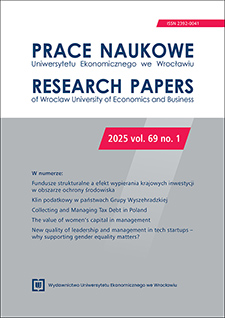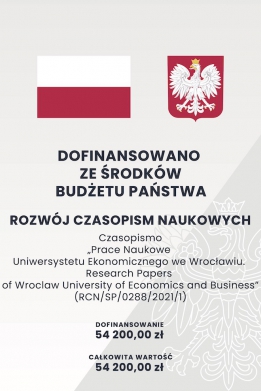Kluczowe obszary badawcze w marketingu terytorialnym w latach 2020-2025
DOI:
https://doi.org/10.15611/pn.2025.1.09Słowa kluczowe:
marketing terytorialny, marketing miejsc, wizerunek miasta, cyfrowi nomadzi, VOSviewerAbstrakt
Cel: Artykuł ma na celu przedstawić zidentyfikowane kluczowe obszary badawcze w marketingu terytorialnym w latach 2020-2025.
Metodyka: W celu identyfikacji materiałów badawczych przeprowadzono analizę literatury, wykorzystując bazę licencjonowaną Web of Science oraz stosując użyte przez autorów słowa kluczowe „marketing terytorialny” lub „marketing miejsc”. Zastosowano kryteria inkluzji obejmujące lata publikacji 2020-2025 oraz materiały w języku angielskim. Do stworzenia mapy wybrano słowa, które powtórzyły się co najmniej 3 razy w zidentyfikowanych artykułach. W rezultacie 66 słów kluczowych utworzyło 5 klastrów reprezentujących różne obszary badawcze.
Wyniki: Na podstawie przeprowadzonego mapowania zidentyfikowano i nazwano kluczowe obszary badawcze w zakresie marketingu terytorialnego, koncentrujące się w ostatnich latach na komunikacji wizerunkowej i budowaniu marki miasta. Badania wskazują, że proces ten powinien w wyższym stop-niu opierać się na wyróżnikach odwołujących się do tożsamości miejsca. Istotnym i aktualnym nurtem badawczym jest także analiza działań marketingowych skierowanych do migrantów, w tym cyfrowych nomadów – tymczasowych pracowników często zmieniających lokalizację.
Implikacje i rekomendacje: Niniejszy artykuł przedstawia rekomendacje dotyczące trzech kierunków przyszłych badań empirycznych, których wyniki mogą dostarczyć istotnych danych wspierających rozwój aktualnych obszarów badawczych w marketingu terytorialnym.
Oryginalność/wartość: Opracowanie syntetycznego przeglądu współczesnych zagadnień związanych z marketingiem terytorialnym umożliwia identyfikację kluczowych problemów badawczych podejmowanych przez naukowców. Systematyczna analiza ewoluujących w czasie kwestii ułatwia konsolidację wiedzy oraz wspiera dynamiczny rozwój tej dziedziny, przyczyniając się do doskonalenia strategii marketingu miejsc.
Pobrania
Bibliografia
Acharya, A., & Rahman, Z. (2016). Place Branding Research: A Thematic Review and Future Research Agenda. International Review on Public and Nonprofit Marketing, 13(3), 289–317. https://doi.org/10.1007/s12208-015-0150-7
Asnawi, A. (2021). Destination Images: Antecedents of City Marketing, Tourism Event, and Social Media Marketing Concept. Jurnal Perspektif Pembiayaan dan Pembangunan Daerah, 9(2), 171–186. https://doi.org/10.22437/ppd.v9i2.12742
Bonneau, C., & Aroles, J. (2021). Digital Nomads: A New Form of Leisure Class? In J. Aroles, F.-X. Vaujany, & K. Dale (Eds.), Experiencing the new world of work (pp. 157–177). Cambridge University Press. https://doi.org/10.1017/9781108865814.011
Casais, B., & Monteiro, P. (2019). Residents’ Involvement in City Brand Co-creation and Their Perceptions of City Brand Identity: A Case Study in Porto. Place Branding and Public Diplomacy, 15(4), 229–237. https://doi.org/10.1057/s41254-019-00132-8
Casais, B., & Poço, T. (2023). Emotional Branding of a City for Inciting Resident and Visitor Place Attachment. Place Brand Public Diplomacy, 19, 93–102. https://doi.org/10.1057/s41254-021-00231-5
Fibingier, E. (2021). Cyfrowy nomadyzm – nowy trend na rynku pracy. Rynek Pracy, 1-2, 19–31.
Florek, M. (2006). Podstawy marketingu terytorialnego. Wydawnictwo Akademii Ekonomicznej w Poznaniu.
Gertner, D. (2011). A (Tentative) Meta-Analysis of the ‘Place Marketing’ and ‘Place Branding’ Literature. Journal of Brand Management, 19(2), 112–131.
Ghafar, N., Ghani, N. M., & Adam, M. (2022). A review of the essence of city branding in enhancing the image and identity of a city. Planning Malaysia, 20(5), 66–78. https://doi.org/10.21837/pm.v20i24.1184
Gilboa, S. & Jaffe, E. (2021). Can One Brand Fit All? Segmenting City Residents for Place Branding. Cities, 116, 103287. https://doi.org/10.1016/j.cities.2021.103287
Glińska, E. (2017). Angażowanie interesariuszy w proces brandingu miasta – teoria versus praktyka. Zarządzanie Publiczne, 40(2), 33-49.
Gosik, B., & Żelazna-Jochim, D. (2018). Tworzenie pozytywnego wizerunku miejsca będącego elementem strategii marketingowej miasta – na przykładzie Tomaszowa Mazowieckiego. Zeszyty Naukowe WSH Zarządzanie, 3, 331–342.
Han, W., Tang, Y., & Wang, J. (2023). The Effect of Identity Salience on Residents’ Engagement with Place Branding during and Post COVID-19 Pandemic. Sustainability, 15(1), 357. https://doi.org/10.3390/su15010357
Hesari, E., Moosavy, S. M., Rohani, A., Kivi, S. B., Ghafourian, M., & Pour, B. (2020). Investigation the Relationship between Place Attachment and Community Participation in Residential Areas: A Structural Equation Modelling Approach. Social Indicators Research, 51, 921-941. https://doi.org/10.1007/s11205-020-02408-6
Huang, Y., J., Cheng, S., Yang, F., Q., & Chen, C. (2022). Analysis and Visualization of Research on Resilient Cities and Communities Based on VOSviewer. International Journal of Environmental Research and Public Health, 19, 7068.
Hunt, J. D. (1975). Image as a Factor in Tourism Development. Journal of Travel Research, 13(3), 1–7.
Kamiński, J. (2011). Istota i etapy marketingu terytorialnego. Studia Ekonomiczne i Regionalne, 4(1), 5–16.
Kavaratzis, M., & Florek, M. (2021). Special Section: The Future of Place Branding. Place Branding and Public Diplomacy, 17, 63–64. https://doi.org/10.1057/s41254-020-00197-w
Kobylińska, U. (2011). Współczesne wyzwania dla miejskich samorządów w zakresie kreowania wizerunku. Zeszyty Naukowe Uniwersytetu Szczecińskiego. Ekonomiczne Problemy Usług, 663(7), 61–71.
Kornak, A., & Rapacz, A. (2001). Zarządzanie turystyką i jej podmiotami w miejscowości i regionie. Wydawnictwo Akademii Ekonomicznej we Wrocławiu.
Kotler, Ph., & Barich, H. (1991). A Framework for Marketing Image Management. Sloan Marketing Review, 32(2), 94–104.
Kotler, Ph., Armstrong, G., Saunders, J., & Wong, V. (1999). Principles of Marketing. Prentice Hall.
Kotler, Ph., Rein, I., & Haider, H. (1993). Marketing Places: Attracting Investment. Industry, and Tourism to Cities, Regions and Nations. Macmillan.
Lhakard, P. (2022). Destination City for Digital Nomads in Thailand: A Case Study of Digital Nomad Community in Chiang Mai. Journal of Humanities and Social Sciences Studies, 4(1), 178–188. https://doi.org/10.32996/jhsss.2022.4.1.18
Mladenović, D. (2016). Concept of “Figure of Merit” for Place Marketing in Digital Nomadism Ages. In D. Petranová, J. Matš, & D. Mendelová, Marketing Identity Conference 2016 (pp. 393–403). Fakulta Masmediálnej Komunikácie.
Moilanen, T., & Rainisto, S. (2009). How to Brand Nations, Cities and Destinations: A Planning Book for Place Branding. Cromwell Press Ltd.
Olsson, K., & Berglund, E. (2010). Rethinking Place Marketing: A Literature Review. 50th Congress of the European Regional Science Association (pp. 1–20). European Regional Science Association.
Orel, M. (2021). Life Is Better in Flip Flops. Digital Nomads and Their Transformational Travels to Thailand. International Journal of Culture, Tourism and Hospitality Research, 15(1), 3–9.
Pasquinelli, C. Trunfio, Bellini, N., & Rossi, S. (2022). Reimagining Urban Destinations: Adaptive and Transformative City Brand Attributes and Values in the Pandemic Crisis. Cities, 124, 103621. https://doi.org/10.1016/j.cities.2022.103621
Silvanto, S., & Ryan, J. (2023). Rethinking Destination Branding Frameworks for the Age of Digital Nomads and Tele-commuters: An Abstract. In B. Jochims, & J. Allen (Eds.), Optimistic Marketing in Challenging Times: Serving Ever-Shifting Customer Needs (pp. 145–146). Springer.
Sokołowicz, M. E., Lewandowska-Gwarda, K., & Przygodzki, Z. (2022). Is the Grass Elsewhere Really Greener? A Study on the Place Marketing Activity of Polish Self-Governments. Bulletin of Geography. Socio-economic Series, 57(57), 7–21. https://doi.org/10.12775/bgss-2022-0020
Sztuk, A. (2022). Competitiveness of Cities in the Post-Pandemic Time: The Perspectives of Residents and Tourists. Ekonomia – Wroclaw Economic Review, 28(3), 129–144. https://doi.org/10.19195/2658-1310.28.3.8
Sztuk, A. (2023). Cities’ Attractiveness Factors from the Perspective of Digital Nomads. Scientific Papers of Silesian University of Technology. Organization and Management Series, 174, 322–336. https://doi.org/10.29119/1641-3466.2023.174.23
Szulce, H., Walkowiak, K., & Florek, M. (2004). Segmentacja jako podstawa zróżnicowania działań marketingowych. Acta Universitatis Lodziensis. Folia Oeconomica, 179(1), 273–284.
Tran, N. L., & Rudolf, W. (2022). Social Media and Destination Branding in Tourism: A Systematic Review of the Literature. Sustainability, 14(20), 13528. https://doi.org/10.3390/su142013528
Van Hoose, K., Hoekstra, M., & Bontje, M. (2021). Marketing the Unmarketable: Place Branding in a Postindustrial Medium-Sized Town. Cities, 114, 103216. https://doi.org/10.1016/j.cities.2021.103216
Vuignier, R. (2017). Place Branding & Place Marketing 1976–2016: A Multidisciplinary Literature Review. International Review on Public Nonprofit Marketing, 14, 447–473.
Wang, X., Lai, I. K. W., & Song, B. (2021). Place Attachment and Affinity: Turning the Mainland Chinese Students into “Word--of-Mouth Champions”. Journal of Hospitality and Tourism Insights, 6(2), 385–403.
Wassler, P., Wang, L., & Hung, K. (2021). Residents’ Power and Trust: A Road to Brand Ambassadorship? Journal of Destination Marketing & Management, 19, 100550. https://doi.org/10.1016/j.jdmm.2020.100550
Widera, W. (2021). Attracting and Pre-Integrating Migrants Using Digital Media in the Local Labour Market. Communication Today, 12(1), 28-42.
Wiśniewska, A. (2011). Kampanie reklamowe w kształtowaniu wizerunku miasta. In A. Grzegorczyk, & A. Kochaniec (Eds.), Kreowanie wizerunku miast (pp. 86–104). Wydawnictwo Wyższej Szkoły Promocji.
Yu, E., & Kim, J. (2020). The Relationship between Self-City Brand Connection, City Brand Experience, and City Brand Ambassadors. Sustainability, 12(3), 982. https://doi.org/10.3390/su12030982
Zenker, S., & Beckmann, S. (2013). My place Is Not Your Place – Different Place Brand Knowledge by Different Target Groups. Journal of Place Management and Development, 6(1), 6–17.
Zenker, S., & Seigis, A. (2012). Respect and the City: The Mediating Role of Respect in Citizen Participation. Journal of Place Management and Development, 5(1), 20–34.
Pobrania
Opublikowane
Licencja
Prawa autorskie (c) 2025 Aleksandra Sztuk

Utwór dostępny jest na licencji Creative Commons Uznanie autorstwa – Na tych samych warunkach 4.0 Miedzynarodowe.
Accepted 2025-04-04
Published 2025-05-28









